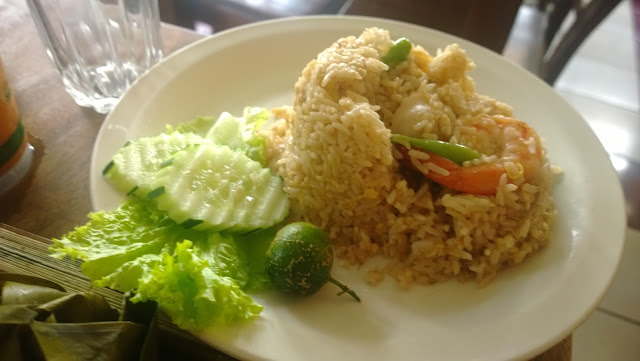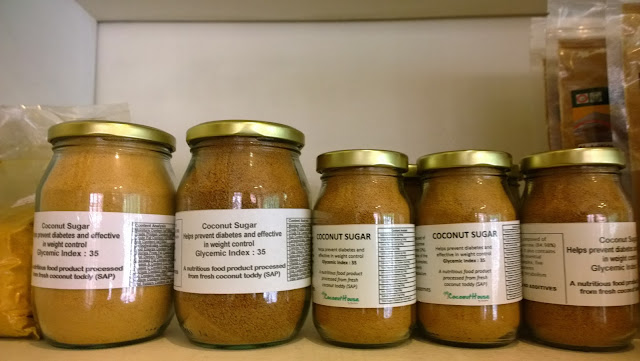These days it seems that every street, barangay, municipality, city has so many new restaurants, cafes, bakeries, etc. Food is a major industry every where you go. Perhaps everyone hears a voice whispering "If you build it, they will come" or words to that effect.
A few months ago, I read an article that Marikina City was another "in" food destination -- a fact that I am sure was already known by the city's residents -- discerning and fastidious foodies who take eating very seriously.
Fortuitously a few days later, I had lunch with Mags, my Marikina based niece and Harry, her husband who is Marikina born and bred.
The thought of good food trumps all shame and good manners so I invited myself to lunch with them, in their own stomping grounds. They were happy and proud to introduce me to the Marikina food scene. I had gustatory visions of trying to eat as much as I could from all the places they told me about.
Mags suggested that we start our eating tour with lunch at her sister-in-law's restaurant, Krung Thai. Mention Krung Thai to a Marikeño and he will immediately tell you that it is the best Thai restaurant, not just in Marikina but in the whole metropolis. I had tried a few of their dishes before, served in Mags' home and remembered how good the food was.
The restaurant is easy to find, after Marikina Bridge turn right on J.P Rizal and left on Paz street. Krung Thai is at the very corner of the Marikina Public market. I met up with Mags, her son Jio and Harry. They were seated and waiting for me when I arrived at Krung Thai.
Krung Thai is owned by Harry's sister and brother-in-law, Ate Betty and Kuya Sorn, a Thai national. While they serve a few non Thai dishes at the restaurant, the showpieces are the Thai specialties which are truly authentic -- honest and faithful to what you would eat in a restaurant in Bangkok.
Ate Betty told us to try her suman, or steamed rice rolls. She said that the smaller, triangle shaped pockets were savoury, not a dessert and something new on the menu.
These little rolls were delicious! More sticky rice dumpling than suman, it was filled with what I think are lentils in a mildly sweet and salty sauce. Did I also detect pork bits? If you're looking forward to lunch, please try not to eat more than one (which is difficult to do) because you need room for the rest of the specialties that Krung Thai is known for.
I let go of my initial idea of grazing through a light meal when the Spring Fried Chicken arrived.
Jio said that the chicken is a favourite of regular diners. It was crisp, juicy and very tasty, from the skin to the perfectly fried meat which was moist and flavourful. I don't know how they cook their Spring Fried Chicken but it definitely beats out the one from the most famous chicken chain, the one whose name rhymes with Fax's.
I had requested for pad thai, my favourite Thai noodle dish. I was glad to see it was served the traditional way and not hidden under an elaborate covering of scrambled egg. Some Thai restaurants try to outdo themselves by creating a "new" look for pad thai when it's really the taste that matters.
In Bangkok, pad thai is really street food -- a quick stir fry that you can get from a cart while you're walking along the road. And yes, like all street food in Bangkok, it will invariably be delicious.
Krung Thai's pad thai was light with a fresh and balanced taste that did not need any additional seasonings. I ate more than I really should have.
Mags and Harry ordered the house best seller -- Tom Yam seafood soup. The soup was fragrant, spicy - sour, just so mouthwatering! There were more than ample pieces of tender squid, large fresh shrimp suahe and fish slices. I could easily order just this one dish and not want for anything else.
To ensure the freshness and quality of food, each dish is cooked just when you order it, no re-heating of pre-cooked food.
The chef - proprietor, Kuya Sorn also takes pride in the presentation of each dish as you can see from this very generous and appetising serving of Mango and Catfish salad.
Mags ordered two kinds of rice -- the more traditional bagoong rice with pork and green mango and a shrimp and seafood rice. I was too full to try both and had just the Shrimp rice which was excellent and full of chunks of shrimp and other seafood.
Let me correct myself ... Krung Thai's Tom Yam soup and their Shrimp and Seafood rice would be all I would want for my next Thai meal.
We ate more than we should at Krung Thai so a visit to Marikina's Lilac Street, with a lot of new restaurants and coffee shops, was suddenly out of the question.
However, my nephew Harry insisted that I could not leave Marikina without a taste of the most famous puto in town. Rocha's Puto & Kutsinta is along J.P Rizal and just about a hundred meters from Krung Thai.
Rocha's store is really small and there was just enough room for Harry (on the left) and another customer. There are cookies, brownies and other sweets for sale but it's the puto kutsinta that is the hands down favourite among Marikeños.
This is my niece, Mags waiting for our order. If you're in Marikina you must not leave without a box of Rocha's. Don't miss it, it's right by the roadside, just a short distance from the public market.
My inner hog took over! The car had barely crossed Marikina Bridge before I opened the box and took out one piece -- and what a delightful melt-in-your-mouth treat it was!
Rocha's Puto tastes like a hybrid -- it's like puto but with the dark orange colour and slight chewiness of kutsinta. Two of my favourite "kakanin" (rice cake) in one delectable bite!
On top of each puto is a small square of cheese -- the coup de grace for your tastebuds.
As it says on the box, "Yummy". I had to keep myself from finishing each and every piece.
Thank you Mags, Jio and Harry for two amazing Marikina food experiences.
I'm sorry I abused your hospitality -- lunch na plus pabaon (take home) pa!
You are forewarned ... I look forward to seeing and tasting more of Marikina in the future!



















































